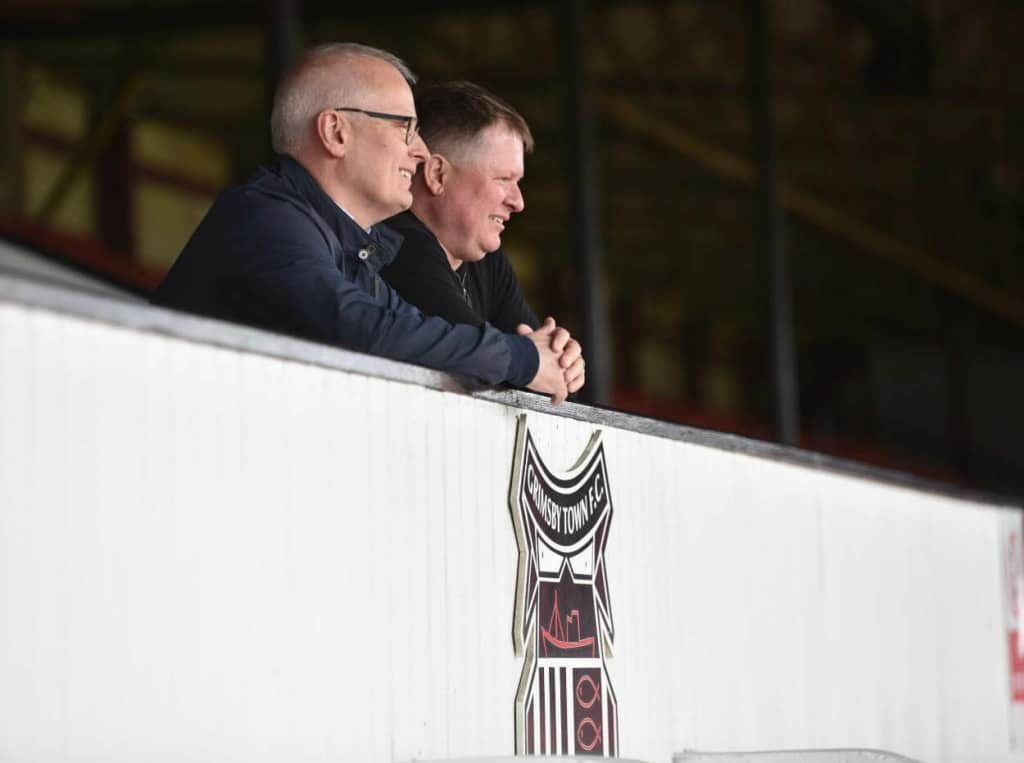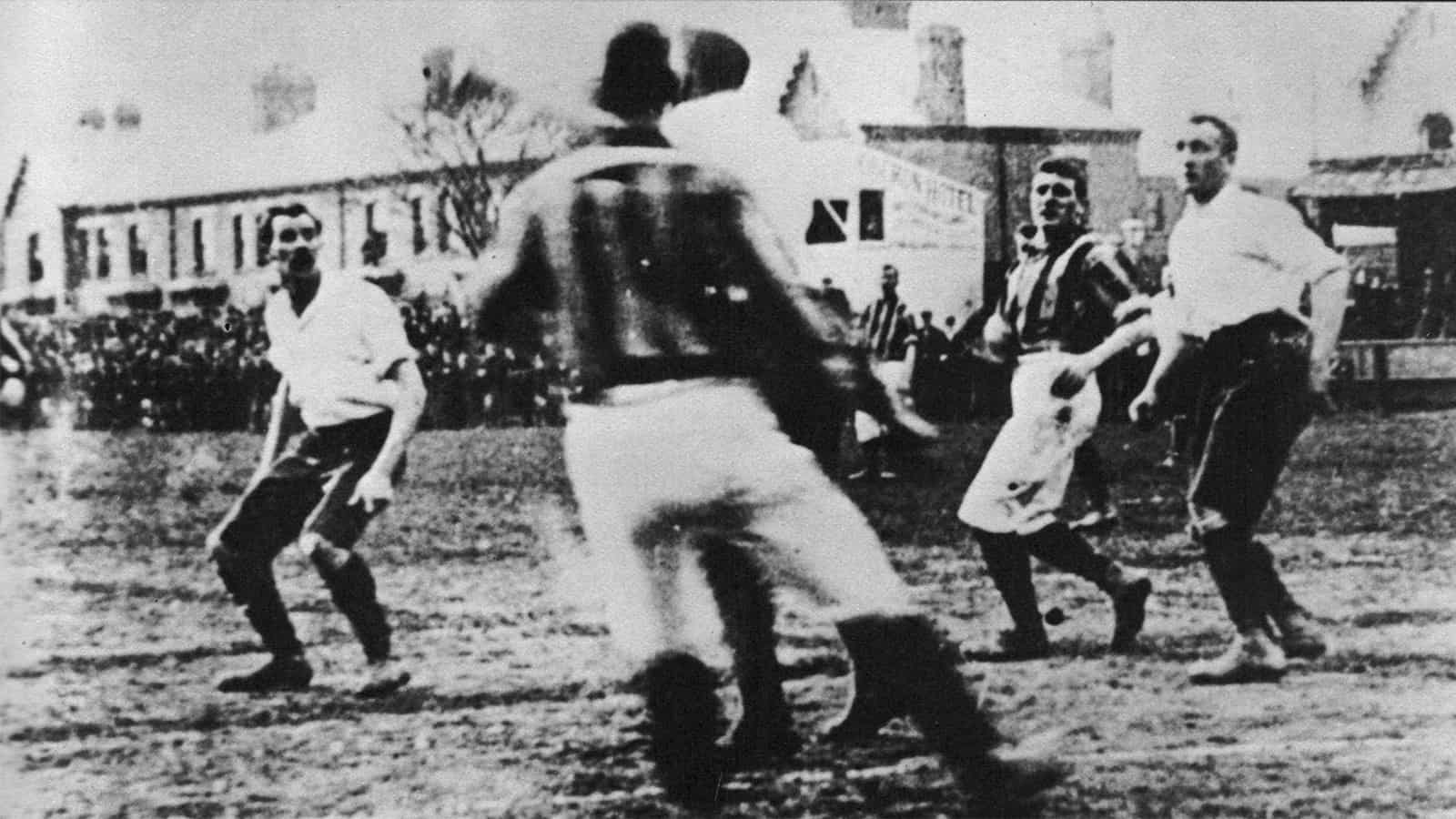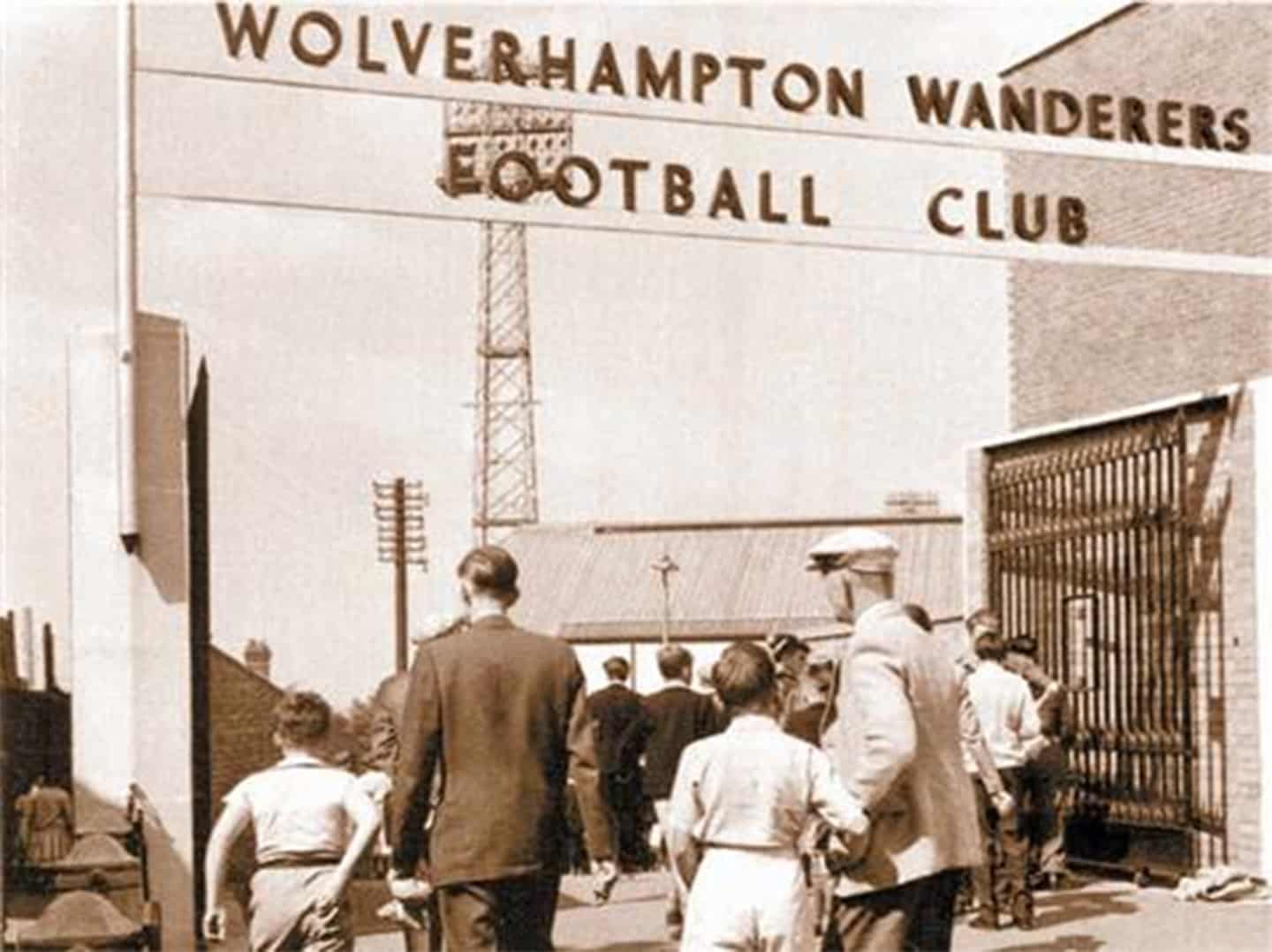
Grimsby Town Football Club is an English football club based in the seaside town of Cleethorpes, North East Lincolnshire.
Founded in 1878 as Grimsby Pelham and later that year changed its name to Grimsby Town. It won many national trophies during the interwar years and again in recent times has played at a high level for a non-league team.
The owners of Grimsby Town Football Club have vowed to make Mariners fans the “heartbeat” of their ambitious project. Jason Stockwood and Andrew Pettit, say they want to make it clear that they are “here for Grimsby.”
The owners of Grimsby Town FC, Jason Stockwood and Andrew Pettit, have made it their mission to ensure that the club is one with a real sense of community, one with great ambition and one where there’s a tangible connection between fans and the club.
The Club History

The club was formed in 1878 after a meeting held at the Wellington Arms public house in Freeman Street.
Several attendees included members of the local Worsley Cricket Club who wanted to form a football club to occupy the empty winter evenings after the cricket season had finished.
The club was originally called Grimsby Pelham, this being the family name of the Earl of Yarborough, a significant landowner in the area.
The name was changed the following year to Grimsby Town. In 1880 the club purchased land at Clee Park which was to become their ground until 1889 when they relocated to Abbey Park, before moving again in 1899 to their present home, Blundell Park – named after Peter Blundell, whose money enabled Sidney Sussex College to buy the land in 1616. The club brought two stands with them from Abbey Park, although the players had to change at the Imperial Hotel.
New Main Stand
In 1901 a new wooden Main Stand was built on the Harrington St side of the pitch. That was the last improvement until 1925, when a grand committee undertook the task of replacing the Abbey Park Stand with the Barret’s Stand
New Osmond Stand
In 1939, the last relic of the old Abbey Park (the Hazel Grove Stand) was replaced by the Osmond Stand.
New Pontoon Stand
Floodlit football was introduced in 1953, and eight years later the Pontoon Stand was replaced by a structure of the same name.
The New Findus Stand
Promotion in 1980 saw the start of further changes. Following the Main Stand was made ‘all seating’ and the Barrett Stand made way for the Findus Family Stand.
The Findus stand was made all seating in 1995.
Other interesting facts.
The original colours were blue and white hoops, which were changed to chocolate and blue quartered shirts in 1884.
In 1888 the club first played league football, joining the newly-formed ‘Combination’. The league soon collapsed and the following year the club applied to join the Football League, an application that was refused. Instead the club joined the Football Alliance. In 1890 the club became a limited company and in 1892 finally entered the Football League, when it was expanded to two divisions. The first game was a 2-1 victory over Northwich Victoria.
The Inter-War Years
This was probably the most suceessful period in the club’s history as they played at the highest level. The first full season after the Great War the club was relegated to the new Third Division North. By 1929 they were however back in Division One, where they stayed (with a brief break from 1932 to 1934) until 1939, obtaining their highest-ever league position, 5th in Division One, in the 1934-35 season. In 1925 they adopted the black and white stripes as their colours.
On 25 March 1939, Wolverhampton Wanderers played Grimsby Town, in a FA Cup semi-final at Old Trafford. The attendance of 76,962 remains Old Trafford’s largest ever attendance, though it is likely to be exceeded in the near future.
The Mariners lost the game 5-0 after the second choice goalkeeper George Moulson was injured early on in the match (first choice keeper George Tweedy had caught the flu days earlier).
With the then rules forbidding substitutes for injuries Grimsby had to play with 10 men and an outfield player in goal. It was at this match that the squad wore numbered shirts for the first time, three months before it became official.
DIVISION TWO
Champions 1900-01, 1933-34
Play-off winners 1997-98
DIVISION THREE
Champions 1925-26, 1955-56, 1979-80
DIVISION FOUR
Champions 1971-72
FOOTBALL CONFERENCE
Play-off winners 2015-16
AUTO WINDSCREENS SHIELD
Winners, 1997-98
LEAGUE GROUP CUP
Winners, 1982
LINCOLNSHIRE SENIOR CUP
Winners 1885-86, 1888-89, 1896-97, 1898-99, 1899-1900, 1900-01, 1901-02, 1902-03, 1905-06, 1908-09, 1912-13, 1920-21, 1922-23, 1924-25, 1928-29, 1929-30, 1932-33, 1935-36, 1936-37, 1937-38, 1946-47, 1949-50, 1952-53, 1967-68, 1972-73, 1975-76, 1979-80, 1983-84, 1986-87, 1989-90, 1991-92, 1992-93, 1993-94, 1994-95, 1995-96, 1999-2000, 2011-12, 2012-13
RECORDS
HIGHEST LEAGUE ATTENDANCE
26,605 v Stockport County on 11 April 1952
HIGHEST FA CUP ATTENDANCE
31,651 v on 20 February 1937
HIGHEST LEAGUE CUP ATTENDANCE
23,115 v Wolverhampton Wanderers F.C on 4 December 1979
HIGHEST NEUTRAL VENUE ATTENDANCE
76,972 v Wolverhampon Wanderers 25 March 1939, FA Cup Semi-Final, Manchester
HIGHEST LEAGUE HOME WIN
8–0 v Tranmere Rovers, 4 September 1925
HIGHEST LEAGUE AWAY WIN
7–0 v Bristol Rovers, 14 December 1957
MOST LEAGUE GOALS IN A SEASON
Pat Glover, 42 goals (1933–34)
HIGHEST LEAGUE SCORER
Pat Glover, 180 goals (1930–39)
MOST APPEARANCES (all competitions)
754 by John McDermott from between 1987 and 2007
HIGHEST TRANSFER FEE PAID
£550,000, Lee Ashcroft, Preston North End, 11 August 1998
HIGHEST TRANSFER FEE RECEIVED
£1.5 million, John Oster to Everton, 1 August 1997
YOUNGEST PLAYER
Tony Ford, 16 years and 143 days v Walsall on 4 October 1975
OLDEST PLAYER
Peter Beagrie, 40 years and 322 days, v Hartlepool United, 26 September 2006
LONGEST SERVING CURRENT PLAYERS
James McKeown – August 2011
1902-1920 H.N Hickson
1920 Haydn Price
1921-1924 George Fraser
1924-1936 Wilf Gillow
1932-1936 Frank Womack
1937-1951 Charlie Spencer
1951 Frank Womack Caretaker Manager
1951-1953 Bill Shankly
1954 Elemér Berkessy Caretaker Manager
1954-1955 Billy Walsh
1955-1959 Allenby Chilton
1960-1962 Tim Ward
1962-1964 Tom Johnston
1964-1967 Jimmy McGuigan
1967-1968 Don McEvoy
1968-1969 Bill Harvey
1969-1971 Bobby Kennedy
1971-1973 Lawrie McMenemy
1973-1975 Ron Ashman
1975-1976 Tommy Casey
1976-1978 John Newman
1979-1982 George Kerr
1982-1985 Dave Booth
1985 Peter Grotier Caretaker Manager
1985-1987 Mick Lyons
1987-1988 Bobby Roberts
1988-1994 Alan Buckley
1994-1996 Brian Laws
1996 John Cockerill Caretaker Manager
1997 Kenny Swain Caretaker Manager
1997-2000 Alan Buckley
2000 John Cockerill Caretaker Manager
2000-2001 Lennie Lawrence
2001-2004 Paul Groves
2004 Graham Rodger Caretaker Manager
2004 Nicky Law
2004-2006 Russell Slade
2006 Graham Rodger
2006 Stuart Watkiss Caretaker Manager
2006-2008 Alan Buckley
2008 Stuart Watkiss Caretaker Manager
2008-2009 Mike Newell
2009-2011 Neil Woods
2011 Dave Moore Caretaker Manager
2011 Rob Scott, Paul Hurst
2013-2016 Paul Hurst
2016-2017 Marcus Bignot
2017-2018 Russell Slade
2018 Paul Wilkinson Caretaker Manager
2018-2019 Michael Jolley
2019 Anthony Limbrick Caretaker Manager
2019-2020 Ian Holloway
2021-2023 Paul Hurst
2023-Present David Artell

Grimsby Town F.C. was formed in 1878 after a meeting held at the Wellington Arms public house in Freeman Street. Several attendees included members of the local Worsley Cricket Club who wanted to form a football club to occupy the empty winter evenings after the cricket season had finished.
The club was originally called Grimsby Pelham, this being the family name of the Earl of Yarborough, a significant landowner in the area. In 1880 the club purchased land at Clee Park which was to become our ground until 1889 when we relocated to Abbey Park.
Clee Park is not far from Blundell Park (which is where the Brick and Tile works are shown on the map). All of that area is now built up with early 20th century terraced housing.

Town also played one or two games in a field near Grimsby Docks Station – thought to be alongside the railway line just south of the station.
The first ever game at Clee Park was against Brigg, which Pelham lost 4-1. The grand sum of 6/9d (33p) was taken on the gate.
In 1880, the club moved its headquarters from the Wellington Arms rooms to the more sensible surroundings of Drings Hotel (where the Grimsby Telegraph offices now stand).
Admission prices for the 1884/ 85 Season were increased to five shillings (25p), plus two shillings and sixpence for a view from the grandstand.
In 1889 the club moved to a new stadium at Abbey Park, with stands from Clee Park being dismantled and re-erected at the new ground. The cost of relocation was in excess of £300.
The exact position of Abbey Park was situated off Welholme Road (below), near to Peoples Park and Farebrother Street.

Picture: Abbey Park – off Welholme Road
The old grandstand was rebuilt on the Welholme Road side, running along the side of the pitch. On the opposite side was a huge open banking which could hold around 8,000 spectators. The second stand was moved from Clee Park, a smaller one, which was erected behind the goal at the Cleethorpes end, and had 300 seats. The total capacity for the stadium was now 10,000.
Season tickets in the grandstand now cost a guinea (£1.05). The opening game was played on the 30th august 1889 versus twice FA Cup finalists and member of the Football League, West Bromwich Albion.
The Main Stand
When fans returned to Blundell Park for the initial top-flight game in September 1901, it coincided with the opening of a new ‘Main Stand’. Based on the pavilion at Hull Town FC, this extended roughly two-thirds along the pitch towards the Cleethorpes End (the spaced posts today give an idea of its original length), the remainder being open terracing.
Its £1,500 cost was raised by the issue of £10 shares which entitled the holder to a reserved seat and reduced admission, while at the end of each season a ballot would be held to pay back a number of shareholders. However, just £800 was raised with directors covering the shortfall, although a Main Stand ‘donation box’ also brought contributions.
Opponents Derby County were also impressed by the new stand, manager Mr. Newbould declaring ‘We have nothing to beat it on our ground’. The local press too, said it offered ‘a very fine view of the game’, but when the reporter in question tried his seat in the new Press Box, glue that had failed to dry tore away part of his trousers!
Town’s aim among the elite was survival, and just three losses at Blundell Park were to contribute to a 15th place finish out of 18 clubs. Among the memories for home fans to savour was the games v Sheffield United and Portsmouth (F.A. Cup) being partly filmed, while in April 1902, Aston Villa were beaten 4-1 to ensure First Division status. When Bill Appleyard completed his hat-trick, supporters enjoyed the sight of England keeper Billy George running to shake ‘Cockles’ by the hand in congratulation!
Afterwards, a Villa director’s claims that his team had been offered money to lose resulted in a Football League Committee meeting, and while GTFC were cleared of any blame, one unnamed individual was banned for life from Blundell Park.
The Findus Stand
Archive footage of the demolition of the Barrett’s Stand and the building of the new Findus Stand.
Originally the club had moved the Abbey Park Stand from the previous ground the Abbey Park Stadium, this stand was eventually demolished in 1925 and was replaced by the Barrett’s Stand.
The Barrett’s itself was eventually demolished in 1980 and was replaced with a two tier stand which was financed by the fish processing firm Findus. The stand therefore was named the ‘Findus Stand’. The stand was opened in 1982.
For the 2016/2017 season, a new sponsorship deal with Young’s Seafood was announced with the Findus Stand becoming the Young’s stand – the Upper Young’s and the Lower Young’s stands.
This freeview video shows the demolition of the Barrett’s Stand and the building a new stand.

Did you know that our floodlight towers are 128ft in height and currently have 45,2000 Watt lamps installed between the four towers? They afford us an average luminance across the pitch of 500 lux, the minimal amount required for EFL League Two.
The floodlights were purchased second hand from Wolves in 1958 and installed in 1960. The Supporters Club raised the £9,000 for their installation with them hooked up to a generator in the old Groundsman’s hut in Constitutional Corner! They were eventually connected to the National Grid via the main power house in Imperial Corner.
The lights were first used for the Reserves v’s Sunderland on Tuesday 13th September, followed by the first team on the 20th September 1960 against Newport County.
Our lights originated at Wolverhampton Wanders’ Molineux Stadium – they were one of the first clubs to them installed at a cost of £10,000! This move enabled Wolves to play evening fixtures with the first being on September 30th 1953. Wolves beat South Africa 3 – 1 on that night with George Best (a boyhood Wolves fan) describing the match as “fantastic” with 55,000 fans locked in Molineux, “but it was the floodlights which made football magical for me, it turned football into a theatre”.
The match as Wolves was the first of a series of prestigious floodlit friendlies that captured the imagination of the nation and were shown on television. Back then only the FA Cup Final and international games were televised however the introduction of floodlights enabled football to be beamed into homes all over Britain.

Following the recent improvements inside Blundell Park, the summer of 1930 then saw the surrounding area changed beyond all recognition.
The space on the Grimsby Road side – empty since the club relocated to Cleethorpes, save for a portion given over to a car park and allotments – saw the building of the Imperial and Constitutional Avenues. One month later, in July 1930, GTFC took advantage of the new Imperial Avenue thoroughfare to construct an archway at the club’s boundary including turnstiles and exit, with the eventual aim that this would mark the official approach to the ground.
Mariners’ supporters of a certain age will remember this impressive arch that remained in place until 1981, when both it and the Barrett Stand were demolished in favour of the new Findus Stand. Consisting of four pillars the middle span displayed the club’s name, while either side were reminders of GTFC’s year of formation (1878) and the year of construction.
Future plans included the building of a new boardroom and offices on a first-floor level to incorporate the arch, but for various reasons this was another idea that failed to get off the drawing board, and fans visiting the ground on official business had to continue making the trek to the other side on Harrington Street.
Town’s home form during 1930/31 was vastly improved from the previous term ensuring a comfortable midtable placing, a position helped by the 8-2 demolition of Leicester City on 1 November – Grimsby’s best-ever win in top-flight football. Tim Coleman’s four goals proved he was an ideal replacement for the transferred Joe Robson, the forward going on to hit 35 goals in only 38 games.

With the 1898/99 season nearing its end, and no new ground on the horizon, there was speculation that GTFC might fold. It was then that local businessman Mr. Alcock – and his purchasing of land in Cleethorpes – came to the attention of club director, Mr.Thompson, a local wine and spirit merchant. The land bought by Mr. Alcock that was to eventually become Blundell Park was ironically only a couple of goal-kicks from the site of Town’s former home at Clee Park.

The 1887 Ordnance Survey map of the area shows that, while the Grimsby side of Park Street was developed, that in Cleethorpes between Grimsby Road and the railway lines was still mostly rural. Indeed, apart from the Clee Park Gardens and Clee Park ground, the only other landmarks of note were a Brick and Tile Works, spring, pond and windmill pump – all in the immediate vicinity of or overlapping the site of the later Blundell Park.
By 1899 however, the familiar street layout from Park Street to Mr. Alcock’s land was in place. Harrington Street though extended only as far as Blundell Street (it was still some years before it became an Avenue), while the Neville, Fuller and Manchester Streets etc. had yet to be built. Nevertheless it was an area of growing population, and Mr. Alcock’s eye for a business opportunity – in this case the building of a hotel (to be known as ‘The Imperial’) on the prime corner of Blundell Street and Grimsby Road – was to become a mecca for residents and thirsty fans alike.
The proposed hotel would though occupy only part of Mr. Alcock’s land, and when GTFC director Mr. Thompson approached him about the availability of the rest, according to one story the meeting took on a comical air. ‘Do you want to make a fortune?’ asked Thompson. ‘Will a duck swim?’ replied Alcock. ‘Very well,’ said Thompson. ‘Build your hotel and lay out a football ground in the rear, and the thing is done.’
Mr. Alcock apparently made his decision so quickly that Mr. Thompson could relay the good news to his fellow directors at the next Grimsby Town FC board meeting!
Lorem ipsum dolor sit amet, consectetur adipiscing elit. Ut elit tellus, luctus nec ullamcorper mattis, pulvinar dapibus leo.
Lorem ipsum dolor sit amet, consectetur adipiscing elit. Ut elit tellus, luctus nec ullamcorper mattis, pulvinar dapibus leo.
